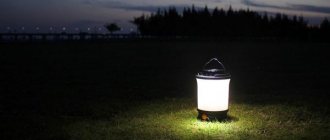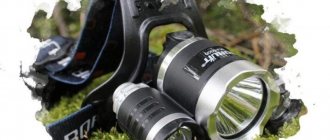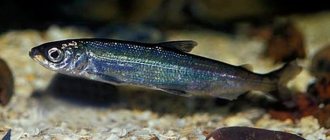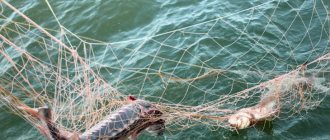For a change, I would like to talk about light bite indicators. In this review, we’ll look at several options for these fishing devices, try to choose the optimal mounting method, and figure out where they can be used. Attention! Only those who read the review to the end will master my writings. As an encouragement, at the very bottom there will be a small laughing master class for a novice feederist (it can compete with a good onigdod).
Seasoned fishermen know that some fish species eat better at dusk or at night. For example, catfish or sometimes carp, bream... But fishing outside daylight hours is very difficult, especially with gear in which it is important to track bites visually. These include side fishing rods with a nod, various types of donks, a float, a feeder (especially a feeder(!)).
As a way out, people use various kinds of electronic alarms or good old bells. But there is another option, which is popularly called “fireflies”, or, as Google translated the inscription on the packaging of the review hero - “Glowing Rod”.
There are several options available in our city. Among them there are “firmA”, and there are very unsuccessful models that shine dimly and have a lot of flash on the outside, on which the fishing line constantly tries to get caught. But the recognizable green packs from the Ocean-sun company are selling out quickly and I like them.
Recently they have risen in price significantly, so when I saw these on ALI at a good price, I ordered them. The lot consists of 50 fireflies with a total price tag of $2.5, which in terms of piece value is about 3-4 times more profitable than offline in the city of Slavyansk, Donetsk region. The goods are still on their way, but I have a lot of them, so I’ll show you what and how, because although the season cannot be said to be in full swing, it has already begun.
How it's packaged, how it works
The package usually contains two fireflies (in my order for ALI there are 5 fireflies in a pack). Sometimes they put some kind of fastener there, mostly a silicone tube. Below in the photo is an American firefly from a well-known brand - there is only one alarm in the pack.
The product is a small stick-flask made of transparent plastic. Here it is even and smooth.
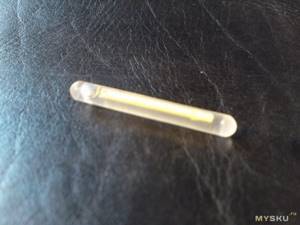
Inside the stick there is some kind of liquid with a light rod floating in it. In order to activate the device, you need to bend the wand so that the rod breaks (preferably several times), and then shake it a little. I saw how some fishermen also chew firefly to further mix the substances. There seemed to be no depressurization with poisoning.
The substances in the flask are mixed, and the solution begins to glow quite brightly with a pleasant green-acid color. They say that in nature there are fireflies that generate red light, but I haven’t come across any of them.
The magic begins.
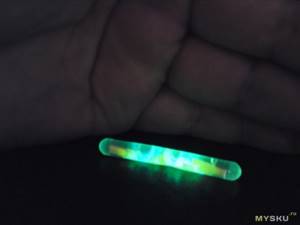
This is how it looks in the dark, already mixed
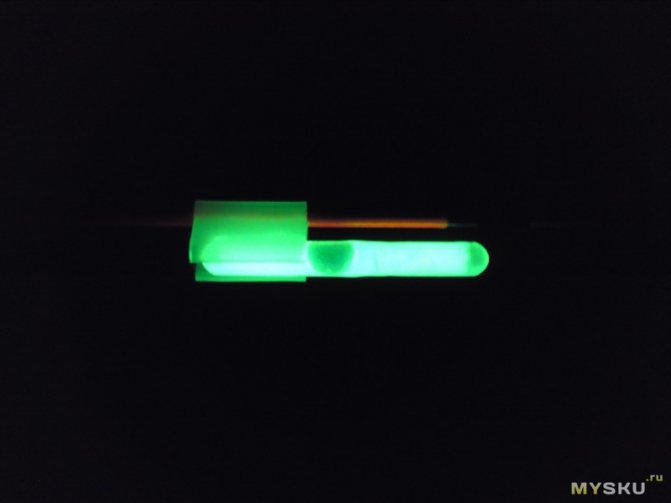
The most intense glow is observed for about 10 hours in a row - such illumination is enough for one night fishing. You can see the green dot from 30-25 meters, at five meters there is generally clear illumination. By the way, on the back of the pack the manufacturer gives a sign indicating the distance, lumens and operating time. It’s difficult to see it without a microscope/magnifying glass, much less take a photo. But in general, the data there is honest - I confirm.
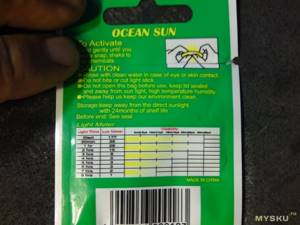
Then the indicator gradually dims, but even after 40 hours there is a faint light. Here you can roughly compare a fresh and almost two-day-old firefly.

What to make a camera from
To make your own underwater camera you will need:
- Battery from a car;
- Waterproof box;
- Inverter;
- Socket adapter;
- Insulating tape;
- The video camera itself;
- Backlight for better visibility;
- Lead weight;
- Glue;
- Container made of plastic material.
«>
How to use
Let me note that I mainly fish with a feeder (English donka).
This tackle is characterized by the use of a sensitive rod with a flexible tip - a “quivertip”. It is the quivertype, with its trembling or twitching, that tells us that the fish needs to be hooked and reeled out. You need to see him if you want to catch him. That’s why they attach a firefly to it at night. We don't like bells and beeping electric alarms. Let's immediately note that the device can also be attached to the float antenna using a standard soft tube. True, it is necessary that the float have an antenna of the same diameter. I have one of these lying around. This is where the smallest glow sticks may be preferable.
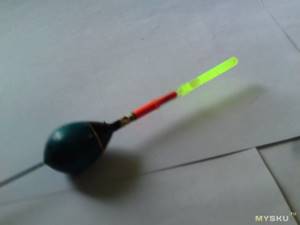
It is also inserted into the famous Chinese bells (there is a special hole in the clothespin). Combining it with a bell is convenient because, for example, when a hunter has several donks and he hears the ringing, he immediately understands from the twitching light which tackle worked.
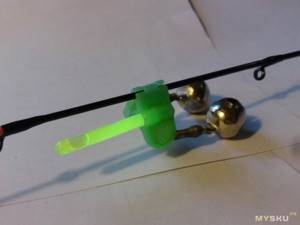
Fixation methods
So, we’ve sorted out the choice, as well as the scope of application.
Let's move on to installation. Installation of a firefly in the feeder business is an extremely important issue. This is because this tackle has to be re-cast very often, the fishing lines and cords used are thin, the rod tips are incredibly elegant, and the equipment (where there is a feeder with bait) is usually quite heavy. If the fishing line gets caught behind the quivertip, then in the best case scenario, we have a “shooting” of the feeder, which flies to the opposite bank. And in the worst case, the fishing rod breaks (mostly the tips suffer, which, unfortunately, can be quite expensive). That is, you need to attach the firefly extremely carefully, and the closer to the tulip, the better the bite will be visible in the dark. Accordingly, you need to choose the mount very carefully. But there are many options, and not all of them are equally useful in certain conditions.
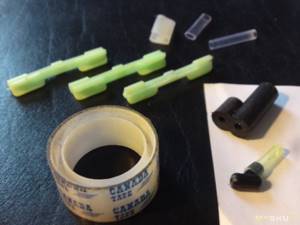
Option 1: The most inconvenient and massive. The grip on the fishing rod is achieved by a cut in the rubber tube. But the diameter of the hole is so large that the firefly will be outside the flexible zone of the tip. And even with small rings, the fishing line will rub against the mount. Conclusion - this product will only be used for relatively coarse gear, for example, for catfish fishing rods.
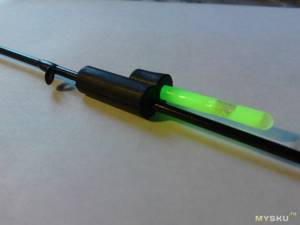
Option 2: Acceptable for the feeder. The green plastic adapter is hooked onto the quiver with multi-directional clips, and the firefly is clicked into the stock.
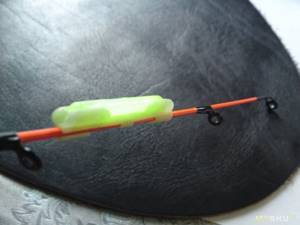
The advantage is that such a mount can be placed between the 2nd and 3rd rings, which is a sound. And it holds tightly and does not turn. The main thing is to choose a plastic for a specific tip diameter, for example, I have two sizes.
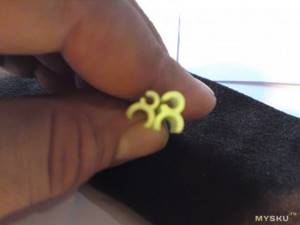
Option 3: Good for feeder. Compact plastic product with two rounded slots. One for the stick, the other for putting on the tip. I really like it because you can hook a fastener between the first and second rings of any feeder rod - and this means sensitivity and a chance to catch cautious fish that bite delicately.

Option 4: Very good. A thing with a tap (I don’t remember the manufacturer now - some expensive, branded one). A split plastic part in the form of an oblique tee has a longitudinal section. It wraps around the quiver and is compressed/fixed with a silicone tube, into which the firefly is actually inserted. The disadvantage is that you need to place it relatively far from the tulip. A huge plus is that the firefly is clearly visible, even when the tip is strongly bent, for example, by a current.
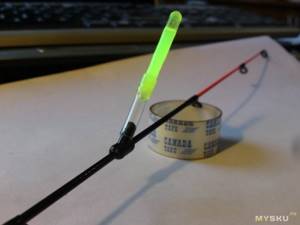
Option 5: Gorgeous, but only suitable for feeders with a small tulip. Here, for fixation, a standard tube is used, which comes in the package. I used to think that it was only intended for a float, but as it turned out... In general, we cut the tube into pieces of 4-5 mm and put it on the quivertip through the tulip.
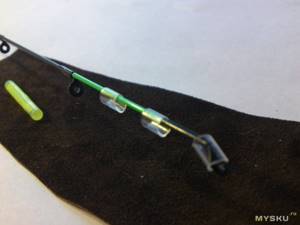
Then we insert a firefly into them (after slobbering first). Pros: it holds very tightly, protrudes minimally above the blank, and is located at the very end of the rod. By the way, you can probably play around with pieces of transparent heat shrink here.
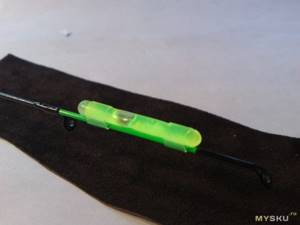
Option 6: The simplest and most reliable. Quite effective. We take narrow stationery tape and wrap the activated firefly where we like. There is a trick here - it’s better to make a smooth transition from the indicator light to the tip, then the line simply won’t have anything to cling to.
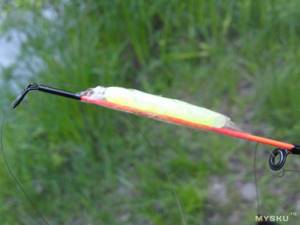
Step-by-step assembly of an underwater video camera
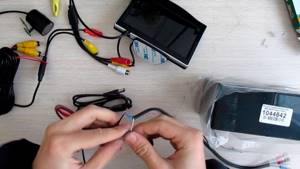
- Test the functionality of a small TV in the mode of displaying video information from a video camera. There should be no interruptions in operation.
- Test the operation of the video camera together with the TV. If the picture is clear and stable, then the video camera is placed in a plastic container. Moreover, it is necessary to ensure that it is well fixed. Holes are made in a certain place and wires are pulled through them.
- Make weights of a certain shape from lead and place them inside a plastic container.
- Make holes for the backlight bulbs in the right place, and then place them there. The light bulbs should already be connected to the wires. The places where the wires come out are carefully sealed with glue and insulated. This is necessary to prevent water from getting inside. The wires from the light bulbs are connected to the camera cable.
- It is very important to position the video camera correctly. It should look forward, that is, be positioned horizontally and transmit a clear picture to the TV screen. You need to make sure of this before sealing it. At the same time, you need to make sure that all wires are connected to the video camera, including those from the power source, as well as to ensure that the device is charging.
- If everything works correctly and all elements are installed, begin the sealing process. Today, the best sealant is silicone or special sealants. It is very important that the sealing is perfect.
- To make it easier and more convenient to lower the underwater video camera for fishing into the hole (well, not by the wires), you need to provide for fastening a strong, preferably artificial, rope that is not afraid of water. This will make it possible to lower the video device to the desired depth.
- Particular attention should be paid to charging the battery. It must always be kept charged and charged immediately after arriving from fishing, otherwise it may fail at the most inopportune moment.
ASSEMBLY OF AN UNDERWATER CAMERA FOR 3 THOUSAND. RUBLES
How to replace chemical firefly
Now a few words about what can be used to replace chemical firefly in the absence of one. I always have three special things in my fishing box: 1) A small LED flashlight with a clothespin that can be attached to the stag and illuminate the quivertip with it. 2) Battery-powered fireflies - capsules with a sealed rubber gasket and thread, inside which there is a red/green LED and 2 LR41 tablets. 3) 5-hryvnia lighter “with a flashlight”. She helped me out once. We ran out of fireflies, but I really wanted to go fishing. I bought a lighter in a village store, unscrewed a lighting device (3 tablets and an LED) and tied it to the tip of the fishing rod. It shined on me for more than 2.5 fishing trips.
Conclusions: What can we say? • The device is indispensable for night fishing. • It is more compact and lighter than LED options. • Many fastening methods. • The bite can be seen better than under the light of flashlights aimed at the fishing rod. • Does not attract midges and mosquitoes. • Cheaper than any other competitors in terms of visual bite signaling. • This particular model shines well and lasts a long time, the body is smooth. • There are other applications if you use your imagination. Probably, it can be used in some emergency options for illuminating a pet (attach it to the dog’s collar). You can attach it to the rear fender of a bicycle or to clothing, and especially fun bikers can stick the alarm on the spokes - for, so to speak, tuning. I don’t know... – you can still use a quadcopter...
Click if you want to laugh at the fishermen
For the patient ones, I suggest you read a little joke about feeders as a snack, well... so that you understand what goes where. 1. When going fishing, you shouldn’t dig for worms, much less buy them in a store. You will forget them at home anyway. It’s much better to then run along the shore and beg for bait from your neighbors. 2. Having arrived at the place, the first thing to do is start feeding - eat all the sandwiches and pies that you took with you. 3. Make fish food - stir the dry mixture in a bucket, scoop up some water, add, mix thoroughly. 4. Fish your mobile phone out of the water where it fell when you were filling up with water. Remove the battery from it and put everything in the sun to dry. 5. While the bait is arriving, arrange the place so that it is as inconvenient as possible. Place feeder stands, a platform or a chair, and lay out the landing net. 6. Feed the selected point using a slingshot. 7. Assemble the feeder, place the reel, tie the feeder. 8. Tear off the feeder, thread the line through the rings and tie again. 9. Fill the feeder with groundbait. 10. Unhook the hook from your pants. 11. Cast, make sure that you do not cast to the feeding area. 12. Tie a heavier feeder and cast with maximum force. 13. Attach a new feeder and call an ambulance for the fisherman on the other side. Give it up. 14. Remember that you forgot to tie the hook, tie it. 15. Unhook the hook from your pants. 16. Cast. 17. Remove the rig from the tree. 18. Unhook the hook from your pants. 19. Step off the bait box you stepped on. 20. Gather what's left. 21. Cast. 22. Untangle the braid that is caught behind the tulip, tie a new feeder, replace the broken tip. 23. Unhook the hook from your pants. 24. Dodge the feeding trough flying from the other side. Find it, it will be useful to you. 25. Unhook the hook from your pants. 26. Take off those damn pants!!! 27. Carefully remove the embedded hook from your leg and treat the wound with iodine. 28. Put on pants. 29. Get off the feeder you stepped on while putting on your pants. 30. Throw out all the bait and get ready to go home. There's nothing more to do here. 31. Go back to make sure that the mobile phone left to dry and the forgotten racks are no longer there. 32. On the way home, count your losses. 33. Find the one who advised you to fish with a feeder and punch him in the face. 34. Go to the store and buy fish.

